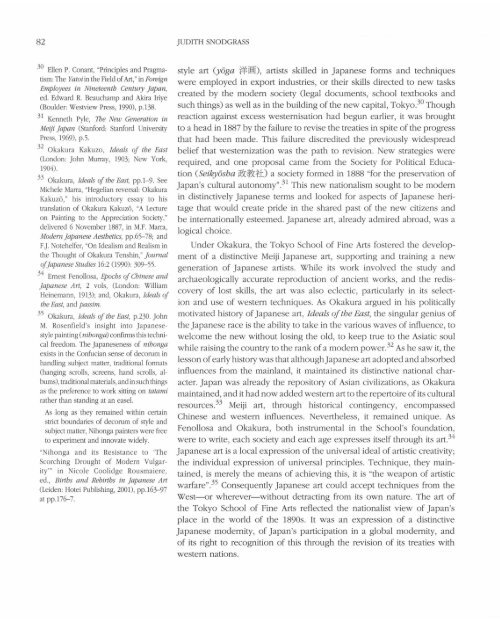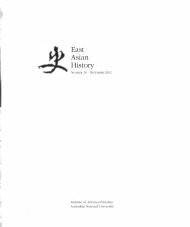Exhibiting Meiji Modernity: Japanese Art at the ... - East Asian History
Exhibiting Meiji Modernity: Japanese Art at the ... - East Asian History
Exhibiting Meiji Modernity: Japanese Art at the ... - East Asian History
- No tags were found...
Create successful ePaper yourself
Turn your PDF publications into a flip-book with our unique Google optimized e-Paper software.
82<br />
JUDITH SNODGRASS<br />
30 Ellen P. Conant, "Principles and Pragm<strong>at</strong>ism:<br />
The Y<strong>at</strong>oi in <strong>the</strong> Field of <strong>Art</strong>," in Foreign<br />
Employees in Nineteenth Century japan,<br />
ed. Edward R. Beauchamp and Akira Iriye<br />
(Boulder: Westview Press, 1990), p.138.<br />
31 Kenneth Pyle, The New Gener<strong>at</strong>ion in<br />
<strong>Meiji</strong> japan (Stanford: Stanford University<br />
Press, 1969), p.5.<br />
32 Okakura Kakuzo, Ideals of <strong>the</strong> <strong>East</strong><br />
(London: John Murray, 1903; New York,<br />
1904).<br />
33 Okakura, Ideals of <strong>the</strong> <strong>East</strong>, pp.l-9. See<br />
Michele Marra, "Hegelian reversal: Okakura<br />
Kakuz6," his introductory essay to his<br />
transl<strong>at</strong>ion of Okakura Kakuz6, "A Lecture<br />
on Painting to <strong>the</strong> Appreci<strong>at</strong>ion Society,"<br />
delivered 6 November 1887, in M.F. Marra,<br />
Modern japanese Aes<strong>the</strong>tics, pp.65-78; and<br />
F.]. Notehelfer, "On Idealism and Realism in<br />
<strong>the</strong> Thought of Okakura Tenshin," j ournal<br />
of j apanese Studies 16:2 (1990): 309-55.<br />
34 Ernest Fenollosa, Epochs of Chinese and<br />
<strong>Japanese</strong> <strong>Art</strong>, 2 vols, (London: William<br />
Heinemann, 1913); and, Okakura, Ideals of<br />
<strong>the</strong> <strong>East</strong>, and passim.<br />
35 Okakura, Ideals of <strong>the</strong> <strong>East</strong>, p.230. John<br />
M. Rosenfield's insight into <strong>Japanese</strong>style<br />
painting (nihonga) confirms this technical<br />
freedom. The <strong>Japanese</strong>ness of nihonga<br />
exists in <strong>the</strong> Confucian sense of decorum in<br />
handling subject m<strong>at</strong>ter, traditional form<strong>at</strong>s<br />
(hanging scrolls, screens, hand scrolls, albums),<br />
traditional m<strong>at</strong>erials, and in such things<br />
as <strong>the</strong> preference to work sitting on t<strong>at</strong>ami<br />
r<strong>at</strong>her than standing <strong>at</strong> an easel.<br />
As long as <strong>the</strong>y remained within certain<br />
strict boundaries of decorum of style and<br />
subject m<strong>at</strong>ter, Nihonga painters were free<br />
to experiment and innov<strong>at</strong>e Widely.<br />
"Nihonga and its Resistance to 'The<br />
Scorching Drought of Mode rn Vulgarit<br />
y'" in Nicole Coolidge Rousmaie re,<br />
ed., Bhths and Rebirths in japanese <strong>Art</strong><br />
(Leiden: Hotei Publishing, 2001), pp.l63-97<br />
<strong>at</strong> pp.l76-7.<br />
style art (yoga # l!!lJ), artists skilled in <strong>Japanese</strong> forms and techniques<br />
were employed in export industries, or <strong>the</strong>ir skills directed to new tasks<br />
cre<strong>at</strong>ed by <strong>the</strong> modern society (legal documents, school textbooks and<br />
such things) as well as in <strong>the</strong> building of <strong>the</strong> new capital, Tokyo.30 Though<br />
reaction against excess westernis<strong>at</strong>ion had begun earlier, it was brought<br />
to a head in 1887 by <strong>the</strong> failure to revise <strong>the</strong> tre<strong>at</strong>ies in spite of <strong>the</strong> progress<br />
th<strong>at</strong> had been made. This failure discredited <strong>the</strong> previously Widespread<br />
belief th<strong>at</strong> westerniz<strong>at</strong>ion was <strong>the</strong> p<strong>at</strong>h to revision. New str<strong>at</strong>egies were<br />
required, and one proposal came from <strong>the</strong> Society for Political Educ<strong>at</strong>ion<br />
(Seikyosha i!&~t±) a society formed in 1888 "for <strong>the</strong> preserv<strong>at</strong>ion of<br />
Japan's cultural autonomy".3 1 This new n<strong>at</strong>ionalism sought to be modern<br />
in distinctively <strong>Japanese</strong> terms and looked for aspects of <strong>Japanese</strong> heritage<br />
th<strong>at</strong> would cre<strong>at</strong>e pride in <strong>the</strong> shared past of <strong>the</strong> new citizens and<br />
be intern<strong>at</strong>ionally esteemed. <strong>Japanese</strong> art, already admired abroad, was a<br />
logical choice.<br />
Under Okakura, <strong>the</strong> Tokyo School of Fine <strong>Art</strong>s fostered <strong>the</strong> development<br />
of a distinctive <strong>Meiji</strong> <strong>Japanese</strong> art, supportirIg and training a new<br />
gener<strong>at</strong>ion of <strong>Japanese</strong> artists. While its work involved <strong>the</strong> study and<br />
archaeologically accur<strong>at</strong>e reproduction of ancient works, and <strong>the</strong> rediscovery<br />
of lost skills, <strong>the</strong> art was also eclectic, particularly in its selection<br />
and use of western techniques. As Okakura argued in his politically<br />
motiv<strong>at</strong>ed histOlY of <strong>Japanese</strong> art, Ideals oj <strong>the</strong> <strong>East</strong>, <strong>the</strong> singular genius of<br />
<strong>the</strong> <strong>Japanese</strong> race is <strong>the</strong> ability to take in <strong>the</strong> various waves of influence, to<br />
welcome <strong>the</strong> new without losing <strong>the</strong> old, to keep true to <strong>the</strong> Asi<strong>at</strong>ic soul<br />
while raising <strong>the</strong> country to <strong>the</strong> rank of a modern power. 32 As he saw it, <strong>the</strong><br />
lesson of early history was th<strong>at</strong> although <strong>Japanese</strong> art adopted and absorbed<br />
irIfluences from <strong>the</strong> mainland, it maintained its distinctive n<strong>at</strong>ional character.<br />
Japan was already <strong>the</strong> repository of <strong>Asian</strong> civiliz<strong>at</strong>ions, as Okakura<br />
maintained, and it had now added western art to <strong>the</strong> repertoire of its cultural<br />
resources.33 <strong>Meiji</strong> art, through historical contingency, encompassed<br />
Chinese and western influences. Nevel<strong>the</strong>less, it remained unique. As<br />
Fenollosa and Okakura, both instrumental in <strong>the</strong> School's found<strong>at</strong>ion,<br />
were to write, each society and each age expresses itself through its art. 34<br />
<strong>Japanese</strong> art is a local expression of <strong>the</strong> universal ideal of artistic cre<strong>at</strong>ivity;<br />
<strong>the</strong> individual expression of universal principles. Technique, <strong>the</strong>y maintained,<br />
is merely <strong>the</strong> means of achieving this, it is "<strong>the</strong> weapon of artistic<br />
warfare".35 Consequently <strong>Japanese</strong> art could accept techniques from <strong>the</strong><br />
West-or wherever-without detracting from its own n<strong>at</strong>ure. The art of<br />
<strong>the</strong> Tokyo School of Fine <strong>Art</strong>s reflected <strong>the</strong> n<strong>at</strong>ionalist view of Japan's<br />
place in <strong>the</strong> world of <strong>the</strong> 1890s. It was an expression of a distinctive<br />
<strong>Japanese</strong> modernity, of Japan's particip<strong>at</strong>ion in a global modernity, and<br />
of its right to recognition of this through <strong>the</strong> revision of its tre<strong>at</strong>ies with<br />
western n<strong>at</strong>ions.
















